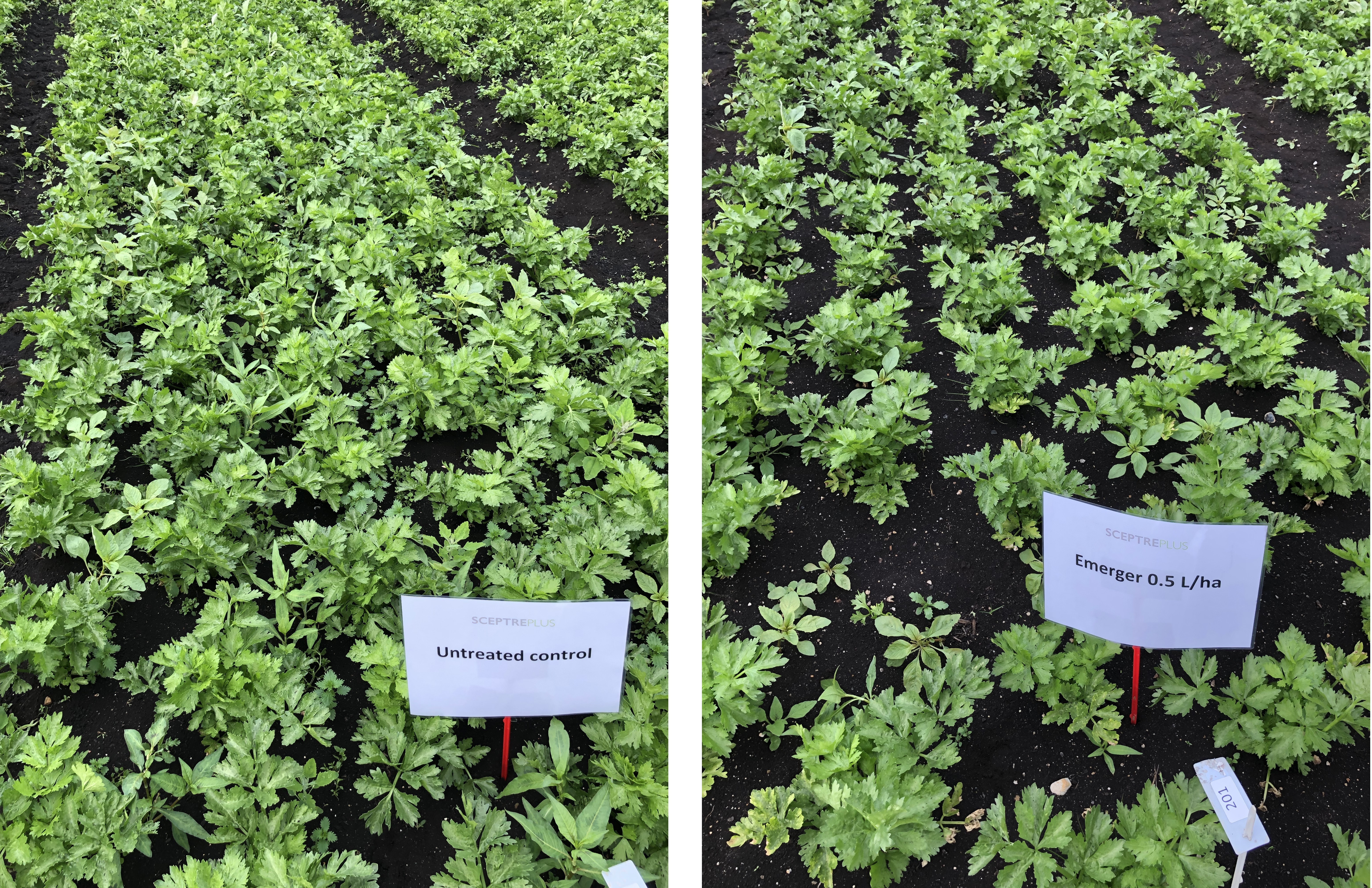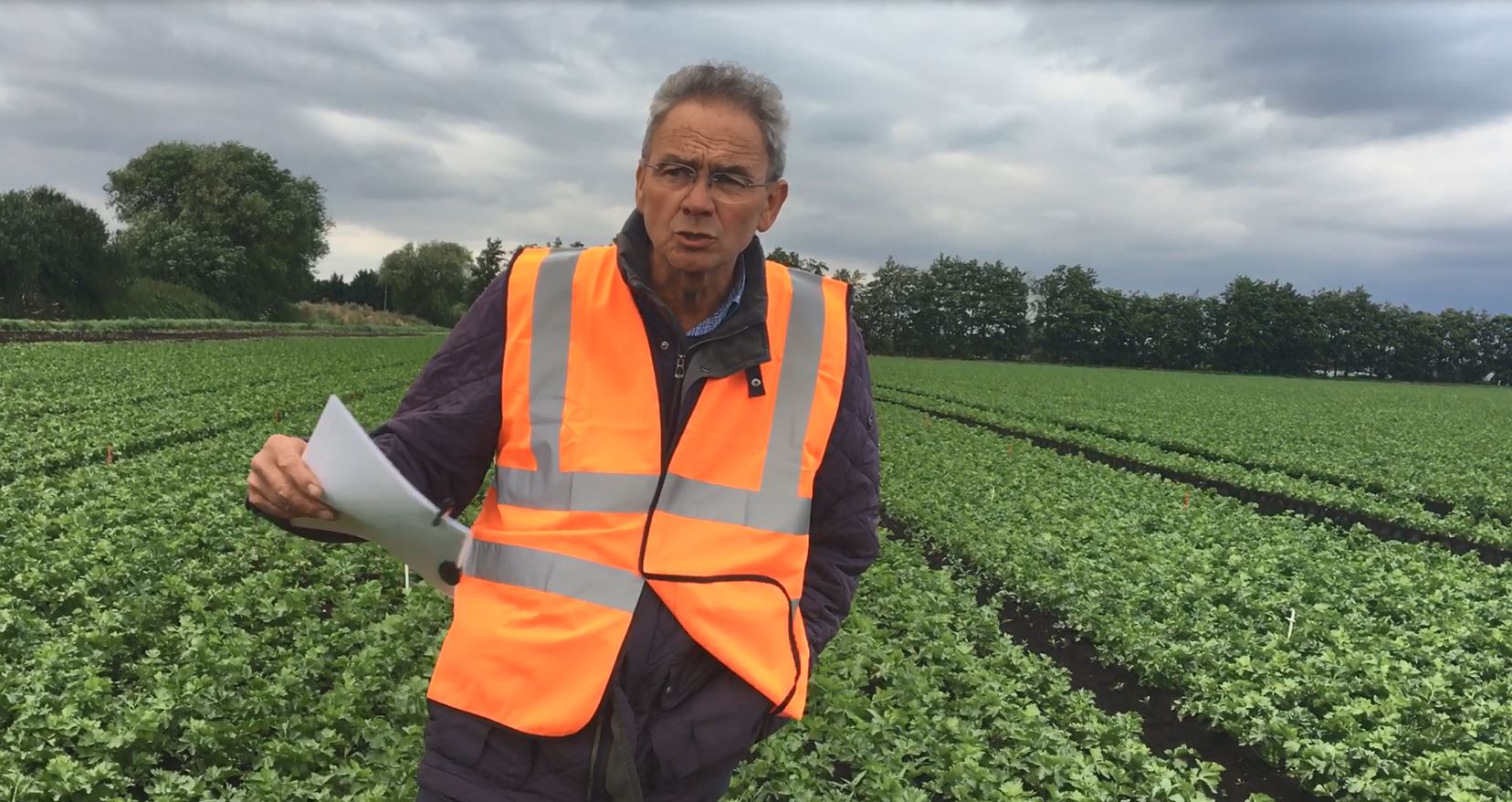Please click here to access the main AHDB website and other sectors.
- Home
- SCEPTREplus: Celery and Herbicide trial summary
SCEPTREplus: Celery and Herbicide trial summary
SCEPTREplus celery herbicide trial: investigating pre and post emergence weed control in celery
With the loss of Linuron trials are underway as part of the SCEPTREplus programme to investigate alternative herbicide options for celery. The trials are taking place in East Anglia.
At this field event, the trials were open for delegates to view the treated plots. The trial is still underway and information especially on the post‐planting trial are still being gathered.
Pre-emergence trial
Three new products are being screened in the pre‐emergence trial, each at two different rates, these are being compared against pendimethalin plus clomazone. The pre‐emergence treatments were applied immediately in front of planting on the day of planting (2nd July). Presently none of the pre‐emergence treatments are showing any adverse crop effects so may potentially be crop safe, however, weed control is relatively poor. It needs to be considered that the soil here is very peaty at around 60% organic matter, while typical of soils that are used to produce celery it means that residual activity of all herbicides is very limited.
Post-emergence contract trial
In the post‐emergence contact trial, the focus is on herbicides to replace linuron, for which approval was revoked last year, this follows on from the previous loss of prometryne several years ago, which means there are no herbicides with significant contact activity on celery. All treatments were applied 14 days after planting. We are examining lower rates of Emerger (aclonifen) at 0.5 L/ha and 0.75 L/ha, to see if we can get the current 90-day harvest interval EAMU reduced to 60 days. There are six other new to celery actives being tested at various rates against the standard of Stomp Aqua (pendimethalin) 2.5 L/ha, plus Defy (prosulfocarb) 5.0 L/ha. No pre‐planting herbicides have been applied to the post‐planting herbicide area.
It is early days for this section of the trial but so far aclonifen (Trts 3 and 4) is showing the typical symptoms of yellow leaf spotting on the treated leaves although the new growth is looking fine. AHDB 9853 (Trt 14) and AHDB 9864 (Trt 10) both at the higher rates are showing some leaf damage and AHDB 9997 (Trt 16) at a higher rate has some leaf spotting on the treated leaf, however, the lower rates of these and most of the other treatments are all looking promising. It is a little early to assess the impact on weeds, but there are some differences and we would expect these actives to have contact effects.
David Norman of Fresh Produce Consultancy Ltd explained the work, highlightkey outcomes to date.
David said:
"We have two trials here, one looking at pre-emergence herbicides and the other looking at post-emergence herbicides. Our main issue, of course, is looking at replacements for Linuron which lost its approval, which left us seeking alternatives for an effective contact herbicide.
In the pre-emergence trial we’ve got three herbicides at two different rates, all crop safe, however, the weed control wasn’t that promising, we will continue investigating additional alternatives.
In the post-emergence herbicide trial, where we sprayed 2 weeks after planting we saw some very promising results. Emerger, which has emergency approval for celery crops and one of the coded actives showed very good potential as a replacement for linuron, we will continue to trial these actives and seek approval for the coded active."

The untreated control (left) in comparison to Emerger 0.5L/ha (right) in the post-emergence trial.
Trial designs
- Fully randomised trial (3 replicates)
- Single untreated control (pre‐planting)
- Double untreated control (post‐planting)
- Plot size: 6.0 m x 2.0 m
Pre‐emergence trial
- Commercial standard
- Stomp Aqua 2.5 L/ha + Gamit 36 CS 1.0 L/ha (treatment 8)
- Sprays applied once on 2 July (19.50C, 4.2 mph wind speed, 90% cloud cover), just in
- front of planting.
- All treatments applied at the same time – 400 L/ha water volume, 02F110 flat‐fan
Post‐emergence trial
- Commercial standard
- Stomp Aqua 2.5 L/ha + Defy 5.0 L/ha (treatment 8)
- Sprays applied once on 16 July (27.50C, 2.2 mph wind speed, 65% cloud cover), 14 days
- after planting.
- All treatments applied at the same time – 400 L/ha water volume, 02F110 flat‐fan
- Nozzles
Assessments:
To be assessed for crop safety and weed control (using weed counts, % cover of each weed species, % overall plot cover of all weeds) at four times as below
- 2 weeks after planting (T2 application)
- 2 weeks after T2 application
- 4 weeks after T2 application
- 6 weeks after T2 application
SCEPTREplus
This follows work carried out for SCEPTREplus in 2017 and is trialing alternatives with potential to replace linuron. Angela Huckle of RSK ADAS Ltd and Debbie Wilson of AHDB will be abkle to answer queries related to the trial and discuss wider SCEPTREplus field vegetable weed control trials which are currently ongoing.
Herbicides were selected in discussion with Bolette Palle‐Neve, David Norman and Angela Huckle, those chosen are approved in the EU or have data on the IR4 database with the aim that they may have a chance of approval on the crop.
This SCEPTREplus event took place on the evening of Wednesday 31 July 2019, in Thetford, East Anglia. Here delegates were shown the trials screening activities for pre- and post-emergence weed control in celery. There was good level of weed germination at the site.




